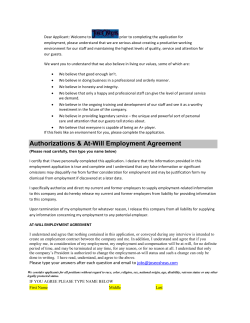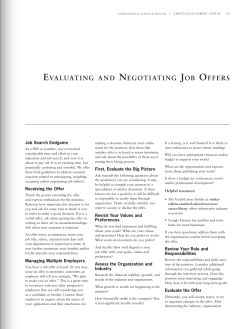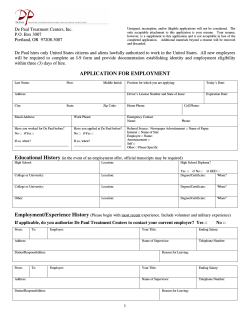
Document 160916
29 August 2007 How to Calculate Man Months and Man Month Rates The terminology “Man Months” is used in many places. During Proposal Preparation and Negotiation stages i.e. for budgeting: Proposers have to provide their Consortium with their “Man Month Rates” and good estimates as to the number of “Man Months” required to carry out the work that is being allocated to them - these figures may be revised during the Negotiation Stage. A Man Month Rate is the amount of money it costs the Organisation to employ a person this is not just the individual’s gross salary. Cost of Employment = Salary + Employers Contribution + any accountable benefits (e.g. Car, Mobile Telephone, Pension, etc.) It is also normal practice to provide a single average for this rate per organisation. When different levels of staff are to be used, for budgetary purposes it is best to use a single weighted average that reflects the relative ratio of different levels of staff. It is of course possible to calculate this using a spread sheet that reflects the envisaged staff time per salary bracket. Participants should also remember that this is a future average for the projected length of the project, so it should take into account envisaged increases and salary levels for the project duration. Use of some properly justified percentage increase per annum for inflation or exchange rate expected fluctuation (for those outside the Euro zone) can be factored in. During Project Reporting: In order to claim funding from the Commission for completed Project work, beneficiaries have to provide the Commission with forms and reports that show how much money was spent carrying out the work and how long it took. For the Financial Reports, you have to declare what the personnel costs were on the project. In order to work them out, you have to know who worked on the project and for how many hours (via timesheets). This figure is then multiplied up by their “Hourly Rate”. This is calculated by taking the monthly gross salary plus benefits plus employer’s costs etc., per employee and dividing this monthly cost by the average monthly number of productive (i.e. excluding sickness, courses, vacations, etc). The personnel cost for the reporting period is the addition of the monthly productive hours on the project multiplied by the month’s calculated hourly rate. In our opinion it is better (and far simpler) if the calculation is based on annual rather than monthly figures. Man Month Calculation It is important that the figures used for salary costs; the hourly rate; the number of net productive hours and man months as reported in the form C, for the Justification of Expenses Report and for the Management (Activity) Report, are all based on the same figures for net productive hours and man months, and are reconcilable one to the other. The organisation should therefore have calculated an estimate for the net productive annual hours per a person or a department, based on an employee working full time. In FP5 the EU determined this would www.finance-helpdesk.org www.efpconsulting.com 1,680 productive hours per annum or 140 productive hours per a month for those working a 5 day 8 hour a day week. In FP7 the organisation has to use their own actual figures and therefore should make its own calculations which may well not be exactly 1,680 hours in a year. Any major variation from 1,680 net productive hours in a year may well be queried by your auditor and/or EU and therefore care should be taken to ensure that there is clear justification for the difference. Man Month Calculation Example Days Annual Less Weekends 365 104 Net 261 National/statuary holidays, etc. Annual vacation Annual sickness Company training / courses Staff meetings, etc. 8 21 12 5 3 49 212 Annual net productive time Hours (based on 8 hour day) = 2,088 = 392 1,696 (141.33 hours per month) This is based on working 8 hours per day not including lunch break. On the basis of this example, the number of productive hours actually reported by each employee will be divided by 141.33, in order to arrive at the main months for the activity reports. Disclaimer The aim and purpose of this and other leaflets is to raise awareness of the framework program financial issues, and not to give legally binding advice. It is intended to provide relevant information which may be of assistance to anyone with financial queries or concerns. This leaflet has been produced jointly under the Finance Helpdesk which was started by the EU IST Finance-NMS-IST project Contract Number:015481, and by EFPConsulting Ltd. Both the Finance Helpdesk and EFPConsulting Ltd. endeavour to deliver a high level service for this purpose. Notwithstanding this, no guarantee can be given on the correctness or completeness of the information provided and neither the European Commission, nor EFPConsulting are responsible or may be held accountable for any loss suffered as a result of this leaflet. Any information given does not necessarily reflect the official position of the European Commission. In this regard, it should be noted that the information provided is considered to be of a first line assistance and users should contact the competent authorities, organisations, or private firms for more detailed information or for advice on any course of action. Authors: Graham Feldman, CPA (Isr.), FCA (UK) Dana Remes EFPConsulting Ltd. www.finance-helpdesk.org Revision: V3 29 Aug 2007 info@efpconsulting.com www.efpconsulting.com
© Copyright 2025





















